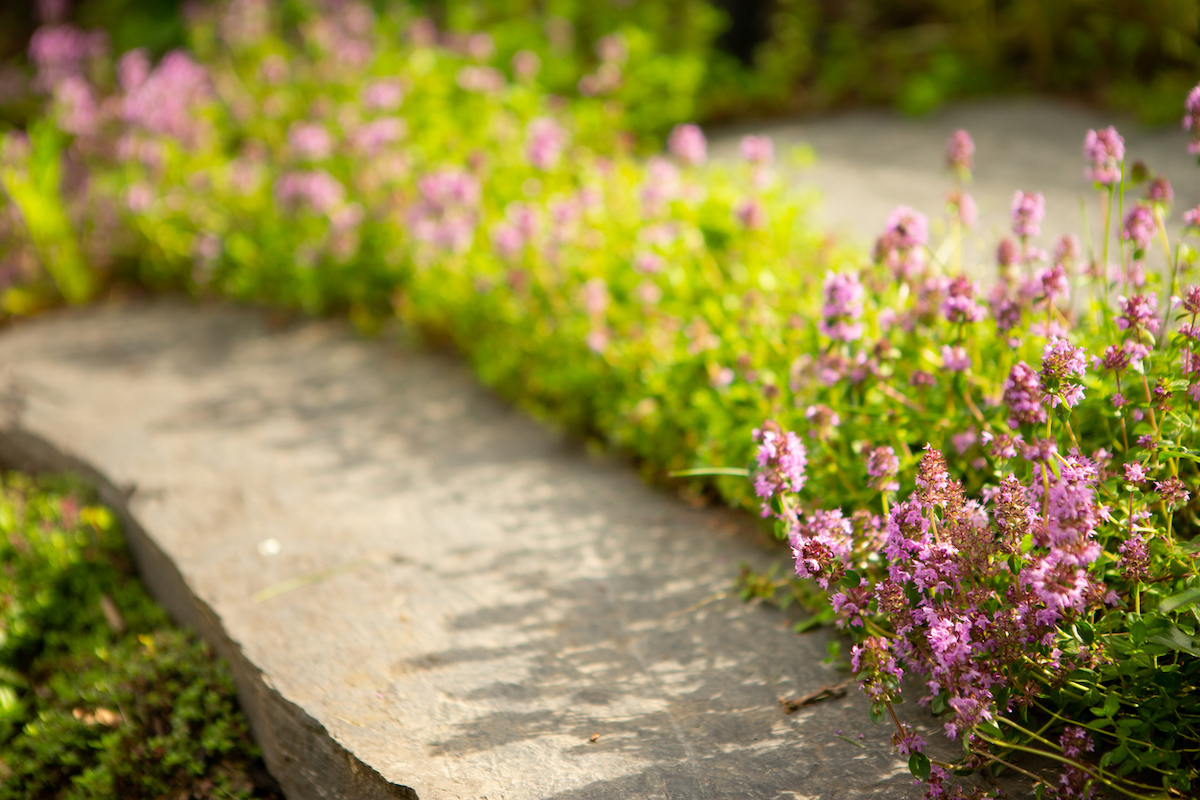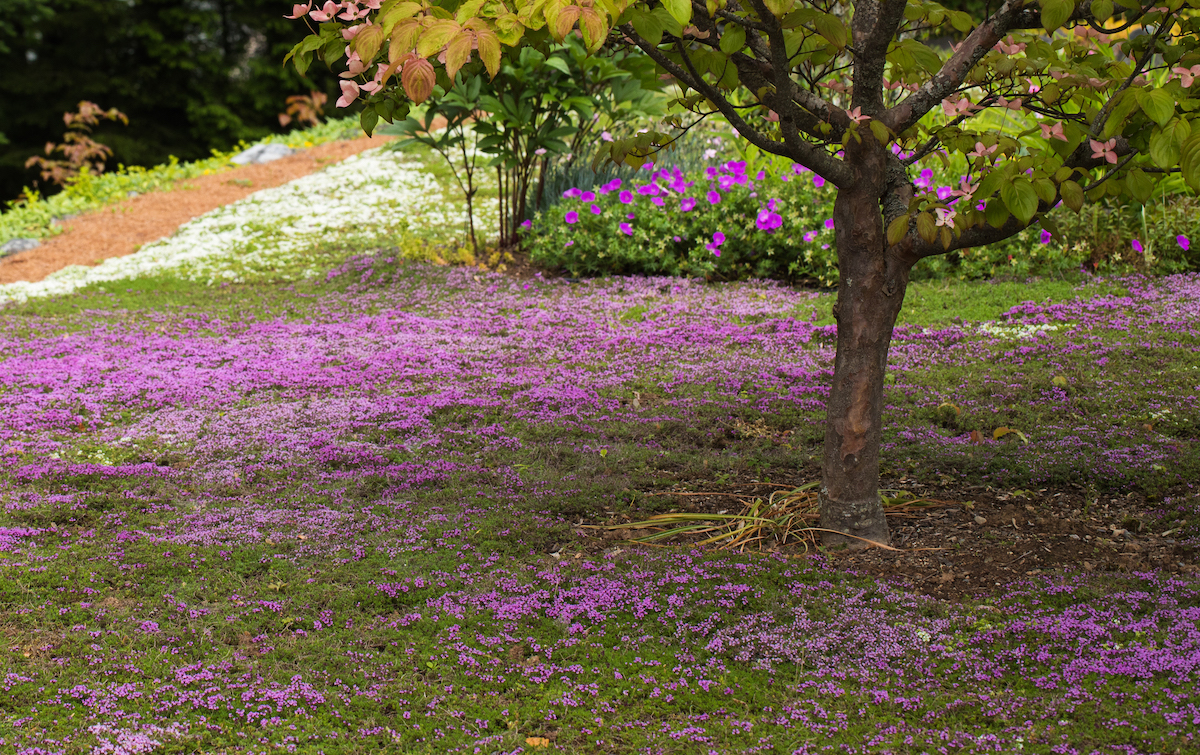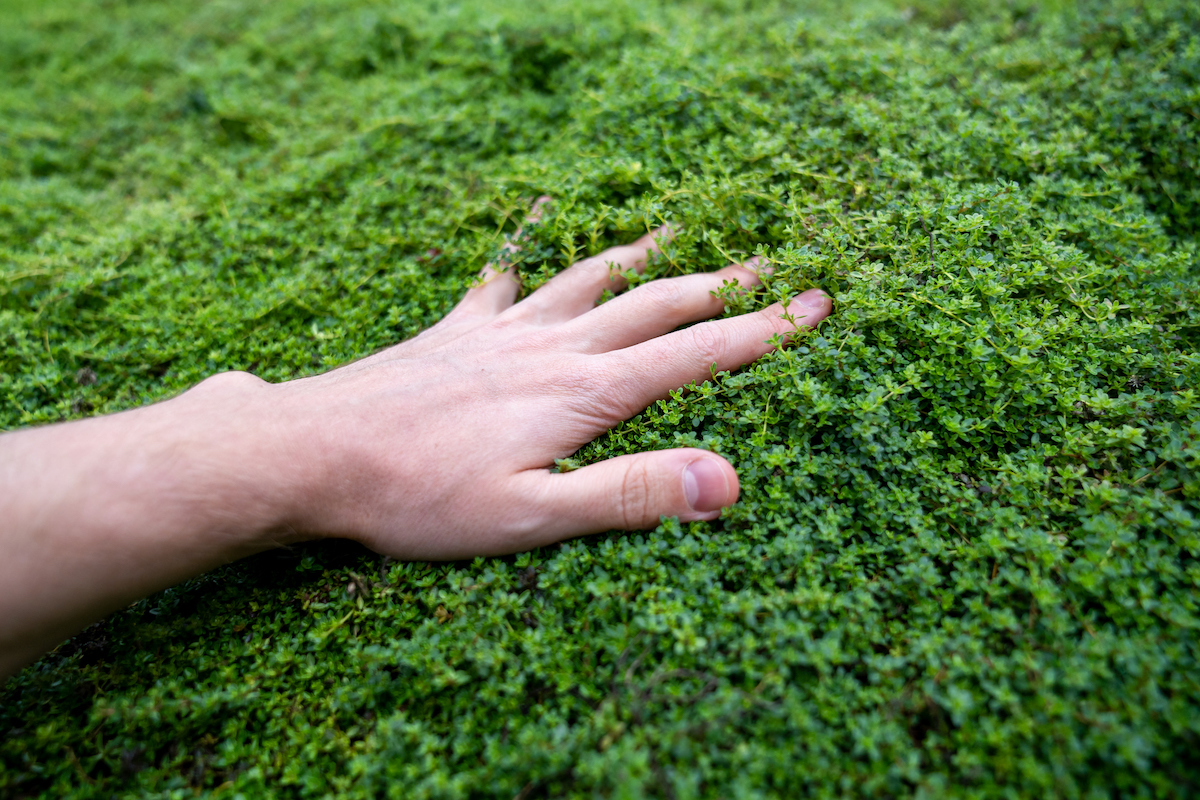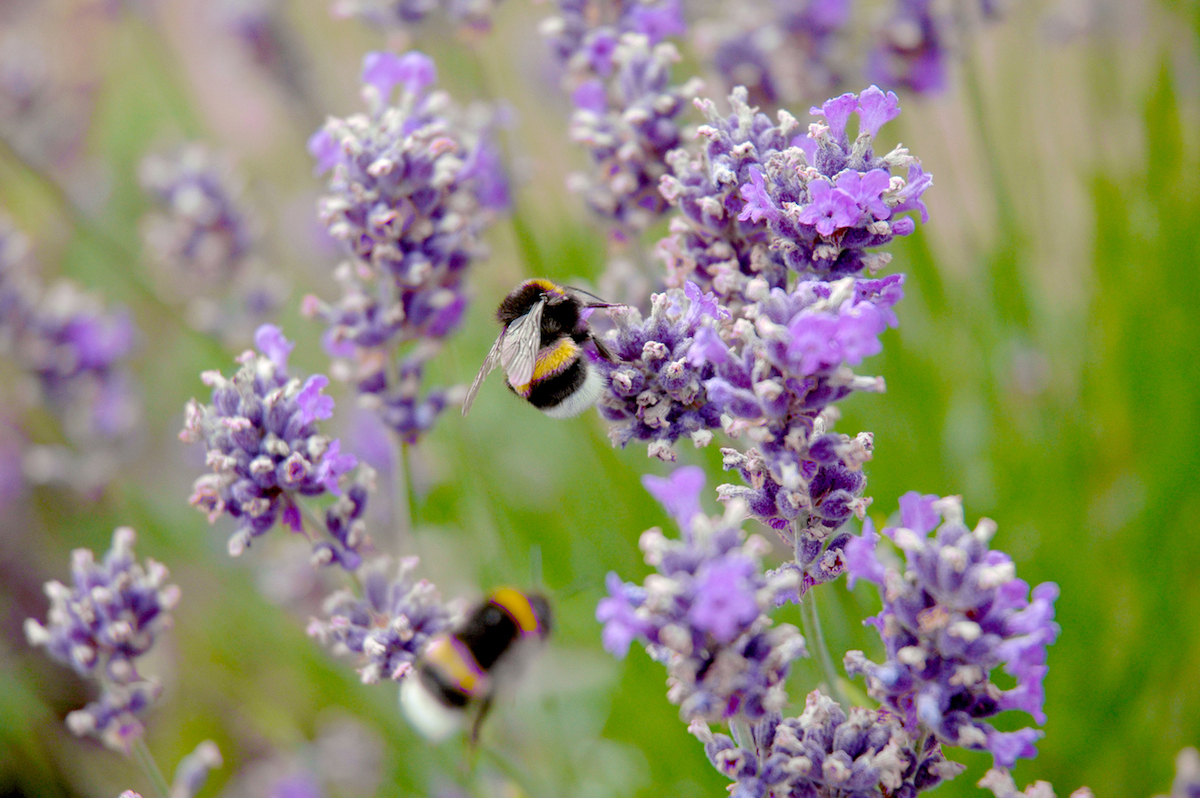

We may earn revenue from the products available on this page and participate in affiliate programs. Learn More ›
You love your lush lawn, but maintaining it takes way too much time and effort. Making the switch to a creeping thyme lawn reaps many benefits, chief among them the ground cover’s minimal maintenance requirements. “Creeping thyme can be a beautiful, low-maintenance alternative to traditional grass lawns, especially in sunny, dry areas,” says Chandler Moncada, who works with CGL Landscaping, which serves the Phoenix, Ariz., area. Many creeping thyme species thrive on neglect, and the plant grows lush and thick without becoming too tall. Soft enough for bare feet but tough enough to handle some tread, a creeping thyme ground cover is an aesthetically pleasing and practical alternative to grass.
With proper preparation and care, creeping thyme can provide a lovely, fragrant ground cover that’s evergreen in USDA zones 4 to 9, and will typically come back in colder zones.

1. You’ll need to remove existing grass first.
If you’re replacing an existing turfgrass lawn, “you’ll need to remove the existing grass,” says Scott McLeod, owner of McLeod Landscaping in Tewksbury, Mass. “Using a sod cutter or thoroughly tilling the soil provides a clean slate for your new ground cover.” Loosen the soil to a depth of about 6 inches, and add organic material to improve drainage and fertility.
Whether planting over an old turfgrass space or a new area of your yard, you’ll need to purchase either seeds or plant starts, says McLeod. “Seed germination can be challenging because it requires consistent moisture and a bit more patience,” he says. Furthermore, according to Moncada, creeping thyme seeds “require light to germinate and should be sown on the soil surface. Scatter seeds over the prepared soil and lightly press them into the soil without covering them,” Moncada says.
While sowing thyme seeds are one option, experts agree that planting small creeping thyme seedlings is a much faster way to cover a space. Although thyme sod is not often available for purchase, McLeod says, using creeping thyme seedlings or plugs can achieve a similar effect. “Plant starts or plugs are generally easier and faster, providing more immediate coverage,” says McLeod. “Creeping thyme generally takes a season to establish and can spread up to 12 inches per year under favorable conditions,” he adds.
2. Creeping thyme requires less water than traditional turfgrasses.
Would you believe it’s possible to have a good-looking, thick, soft ground cover that also saves on water? If you’re looking for a practical reason to switch to a creeping thyme yard, this is it. Creeping thyme varieties are drought-tolerant, requiring much less water than a traditional grass lawn. When hot weather comes, traditional grass lawns start to turn brown, but creeping thyme doesn’t.
In fact, creeping thyme actually dislikes wet conditions. It prefers dry or moist soil, thrives in full sun, and most types love heat—which saves you from having to water constantly. Creeping thyme is susceptible to root drowning and edema, which is why the soil should be moist or dry. All you have to do to take care of a creeping thyme yard is fight the instinct to water it like you would grass. And “be prepared for some initial weed control and occasional watering during dry spells,” says McLeod.
3. A creeping thyme lawn usually won’t grow more than 3 inches high.

Creeping thyme grows at a medium rate, and it “can take a full growing season to establish,” says Moncada. “Once established, it spreads relatively quickly. Generally, you can expect noticeable spread within a year, with fuller coverage in 2 to 3 years,” he adds.
Its height caps out at about 3 inches, which is another excellent quality for a ground cover. Instead of putting energy into growing upward, creeping thyme spreads out, sprawling across and filling in thinly covered or bare areas. This natural tendency to fill in helps careers of creeping thyme always look full. Its dense habit can serve as a barrier to weeds. It is easy to maintain by just trimming around paths or unwanted areas.
Thanks to the herb’s growth rate and low height, you’ll spend less time pushing a lawn mower if you swap your traditional turf for creeping thyme ground cover. The plant is considered a woody perennial, but the woody portion is comfortable to stand on and doesn’t affect your lawn mower if you do choose to mow it. Some gardeners opt for giving their creeping thyme an occasional once-over with the mower to encourage the herb to spread.
“Creeping thyme generally takes a season to establish, and can spread up to 12 inches per year under favorable conditions.”
—Scott Mc Cloud, owner of McLeod Landscaping in Tewksbury, Mass.
4. Creeping thyme has a minty aroma.
Thyme is an herb, so it’s not surprising that it has a pleasant scent and that certain species of creeping thyme make an excellent cup of tea or enhance the taste of a dish. Thyme species come in both fragrant ornamental and culinary varieties. Related to the mint family, the more than 300 thyme species share an aroma profile when crushed or steeped. Some species of thyme incorporate other flavors, such as earthy or lemony tones.
In general, if you want the traditional flavor of thyme for recipes, however, you might not be able to rely on the flavor of a creeping variety. It’s smart to include a few common or English thyme plants (Thymus vulgaris ‘English’) in your ground cover plan. In USDA Zones 5 to 9, they also spread and cover ground, but grow a little higher (6 inches to a foot). Place them out of foot traffic, like at the corner of a lawn or garden bed. Thyme is a great addition to many savory dishes and can be used with or without the stem, depending on the recipe.
5. Deer will steer clear of creeping thyme.
You can always tell which neighborhoods have a deer problem by the condition of the landscaping. Unfortunately, these creatures are just foraging for food that they can’t find in their natural habitat, which means your lawn and garden are on the menu.
While no plants are deer-proof, some are less appealing. Thyme is one of those plants that deer tend to leave alone unless they can’t find something more appealing. While the ground cover creeping thyme falls in the “deer-resistant” category, this doesn’t mean that deer will never eat it. But if given a choice between creeping thyme or something else, they’ll usually opt for the latter.
6. A flowering creeping thyme lawn will attract bees.

In recent years, many species of bees have experienced worrying population declines. Planting a creeping thyme lawn will give those little pollinators something to shake their stingers about, because when the weather warms up, creeping thyme ground cover blooms for a month or two, turning into a carpet of lavender or pink flowers. There’s even a red creeping thyme (Coccineus) that is quite stunning.
The charming flowers are quite small, only about ¼ inch across, but they’re rich in nectar and will draw bees to your yard. While the blossoms generally appear mid-spring, their characteristics and flowering times differ depending on the species of creeping thyme you plant. As a bonus for beekeeper hobbyists, the pollen from creeping thyme adds flavor to the resulting honey.
At the same time, a large swath of creeping thyme can help repel mosquitos.
7. A creeping thyme lawn can stand up to moderate foot traffic.

It’s important that a ground cover to replace the lawn be walkable, and creeping thyme can handle some foot traffic. Don’t let the soft nature or gentle flowers of this herb fool you. Creeping thyme lawns bounce back quickly, even after being trampled by rambunctious kids. “However, it’s not as durable under high foot traffic compared to traditional grass,” says McLeod.
With grass turf, a heavy tread can compact the soil, which can reduce the amount of air and water available to the lawn. Robbed of the nutrients it needs, the grass thins and dies off. This is why you start to see wear in frequently trafficked areas. Once established, creeping thyme stands up to foot traffic because the plants don’t have the water needs of grass, and they help control erosion by filling in sparse areas.
8. Yes, you can harvest the thyme for cooking and other uses—just do it in the morning.
Thyme serves double-duty as a functional herb garden that provides aroma and thyme leaves. It’s best to harvest thyme in the morning, just after the dew has dried. This ensures the highest concentration of essential oils and the most potent flavor. Avoid washing the clean leaves after clipping them as this will remove some of the essential oils.
Essential oil from thyme can be used in perfumes, soaps, and aromatherapy. For the best quality and quantity of essential oil, harvest thyme in the summer. To harvest, simply clip sprigs. Use fresh, crushed thyme for essential oils, fresh common or English thyme in favorite recipes, or dry your cut thyme and store it in an airtight container for later use.
9. Creeping thyme is usually more expensive to plant than grass.
As with everything, there are a few disadvantages of planting creeping thyme as a lawn. For one thing, creeping thyme will set you back more than grass will, warns Moncada. “If using starts or sod,” he says, “the initial cost can be higher than seeding a traditional grass lawn.”
Creeping thyme’s ability to block weeds takes a while; gardeners will have to do manual weed control until the carpet of thyme becomes dense.
Finally, Moncada cautions: “Thyme lawns have a different appearance and texture compared to grass lawns, which might not be suitable for all aesthetics or uses.”
